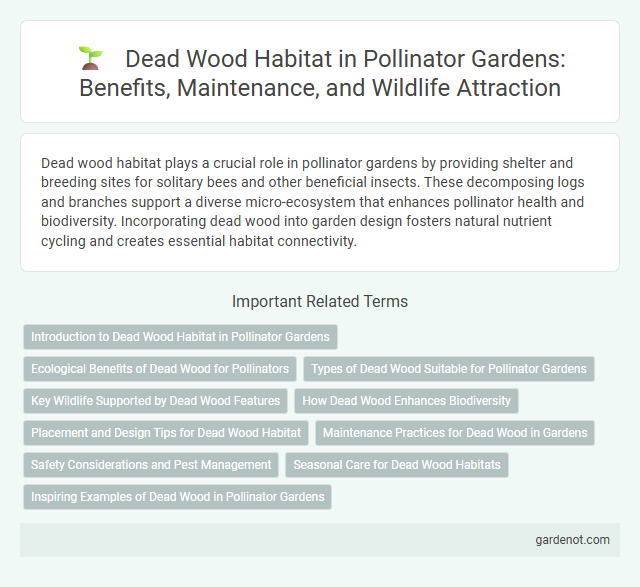Dead wood habitat plays a crucial role in pollinator gardens by providing shelter and breeding sites for solitary bees and other beneficial insects. These decomposing logs and branches support a diverse micro-ecosystem that enhances pollinator health and biodiversity. Incorporating dead wood into garden design fosters natural nutrient cycling and creates essential habitat connectivity.
Introduction to Dead Wood Habitat in Pollinator Gardens
Dead wood habitat in pollinator gardens provides essential nesting and foraging resources for solitary bees and other beneficial insects. Incorporating logs, branches, and stumps creates microhabitats that support biodiversity, enhance pollination, and improve ecosystem health. Maintaining dead wood in garden design promotes natural pest control by attracting predatory insects and fosters a balanced, sustainable environment.
Ecological Benefits of Dead Wood for Pollinators
Dead wood provides essential nesting and overwintering habitats for various pollinators such as solitary bees and beetles, supporting biodiversity in pollinator gardens. It fosters the growth of fungi and lichens, which contribute to nutrient cycling and create a microhabitat rich in food resources. Maintaining dead wood in gardens enhances ecosystem resilience and pollinator population stability by offering shelter and foraging opportunities.
Types of Dead Wood Suitable for Pollinator Gardens
Dead wood types such as fallen logs, standing snags, and decaying branches provide essential habitats for pollinators like solitary bees and beetles. Hardwood species like oak, maple, and ash offer long-lasting decay stages, supporting diverse insect communities critical for pollination. Incorporating various sizes and decomposition levels of dead wood enriches biodiversity and sustains pollinator populations in garden ecosystems.
Key Wildlife Supported by Dead Wood Features
Dead wood habitats provide essential shelter and breeding sites for a variety of pollinators and beneficial insects such as solitary bees, beetles, and butterflies. These features support biodiversity by offering nesting cavities and protection from predators, promoting healthy populations of pollinators critical for garden ecosystems. The presence of dead wood also encourages fungi and microorganisms that contribute to nutrient cycling, enhancing soil health and plant growth in pollinator gardens.
How Dead Wood Enhances Biodiversity
Dead wood serves as a critical habitat for diverse pollinator species, including solitary bees, wasps, and beetles, by providing nesting and foraging sites. Its presence supports essential life cycles and promotes ecological interactions that drive pollination and natural pest control. Incorporating dead wood in pollinator gardens enhances biodiversity by sustaining a wide range of beneficial insects and contributing to a balanced ecosystem.
Placement and Design Tips for Dead Wood Habitat
Strategically place dead wood in sunny, sheltered garden areas to create ideal microhabitats for pollinators like solitary bees and beetles. Use logs, branches, and snags with varied diameters and decay stages to support diverse nesting and foraging needs. Incorporate vertical and horizontal positioning, ensuring stable ground contact and protection from excessive moisture to extend habitat longevity.
Maintenance Practices for Dead Wood in Gardens
Regularly inspect dead wood habitats to ensure structural stability and prevent excessive decay that can diminish their value for pollinators such as solitary bees and beetles. Avoid removing all dead wood; instead, selectively prune damaged sections to maintain microhabitats vital for pollinator nesting and overwintering. Incorporate diverse sizes and stages of decomposition in dead wood piles to support a wide range of pollinator species and enhance overall garden biodiversity.
Safety Considerations and Pest Management
Dead wood habitats in pollinator gardens provide essential shelter for beneficial insects but require careful safety considerations to prevent hazards such as sharp edges or unstable structures. Regular inspection and removal of diseased or moldy wood help minimize pest infestations while supporting native pollinators like solitary bees and beetles. Implementing integrated pest management techniques ensures balance between preserving habitat functionality and controlling harmful insect populations.
Seasonal Care for Dead Wood Habitats
Seasonal care for dead wood habitats in pollinator gardens involves monitoring moisture levels to prevent fungal decay that harms beneficial insects. In autumn, leave dead wood undisturbed to provide shelter for overwintering pollinators like solitary bees and beetles. Spring maintenance includes clearing away debris to ensure emerging pollinators have clear access to nesting sites and food sources.
Inspiring Examples of Dead Wood in Pollinator Gardens
Inspiring examples of dead wood habitats in pollinator gardens include standing snags and fallen logs, which provide essential nesting sites for solitary bees and shelter for beneficial insects like beetles and butterflies. Incorporating hollow stems and drilled wood blocks mimics natural conditions, enhancing biodiversity by supporting pollinator larvae and overwintering insects. These elements foster a thriving ecosystem, promoting pollination while maintaining healthy garden resilience.
Dead wood habitat Infographic

 gardenot.com
gardenot.com